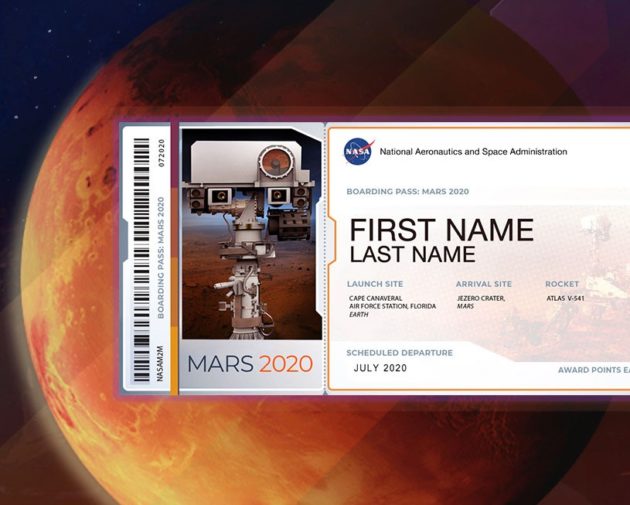
Space fans have been sending their names to Mars and other extraterrestrial destinations for more than two decades, and it’s that time again: From now until Sept. 30, NASA’s Jet Propulsion Laboratory is taking names for the Mars 2020 rover mission.
All you have to do is type your name and location into an online form on NASA’s website and hit the “Send” button. You’ll instantly get the opportunity to print out or save a souvenir boarding pass, listing more than 300 million miles’ worth of faux frequent-flier award points.
Once all the names pass muster, they’ll be handed over to JPL’s Microdevices Laboratory to be etched onto a silicon chip with an electron beam. Each line of text will be a mere 75 nanometers wide — which is less than a thousandth the thickness of a human hair.
That’s small enough to get more than a million names inscribed onto a dime-sized microchip. But even at that rate, it’s likely to take more than one chip to do the job. After all, more than 2.4 million names were etched on two chips that were sent to Mars on NASA’s InSight lander last year.
If anything, the Mars 2020 rover will be an even bigger deal, thanks to its role in NASA’s accelerating campaign to look for evidence of ancient life on Mars.
“We want everyone to share in this journey of exploration,” Thomas Zurbuchen, associate administrator for NASA’s Science Mission Directorate in Washington, said in a news release. “It’s an exciting time for NASA, as we embark on this voyage to answer profound questions about our neighboring planet, and even the origins of life itself.”
The 2,300-pound, car-sized rover is due for liftoff in mid-2020, with touchdown on the Red Planet scheduled for February 2021. The rover’s main mission at Jezero Crater will be to explore what’s thought to be the site of an ancient river delta on the edge of a giant impact basin. The crater’s rocks and soil may contain organic molecules and other traces of microbial life.
“The delta is a good place for evidence of life to be deposited and then preserved for the billions of years that have elapsed since this lake was present,” Mars 2020 project scientist Ken Farley said last November, when NASA revealed where the rover would be going.
The plutonium-powered rover will collect samples for saving up, with the intention of finding a way to return the samples during a future round trip to Mars. NASA also plans to pack a mini-helicopter on the rover, along with an experiment aimed at producing oxygen from Mars’ thin carbon-dioxide atmosphere.
Such a technology could come in handy when astronauts set up shop on the Red Planet, perhaps as early as the 2030s. And who knows? Decades or centuries from now, interplanetary explorers might well be able to recover the name-laden microchips from the Mars 2020 rover’s frame. Let’s just hope they bring their microscopes.
























